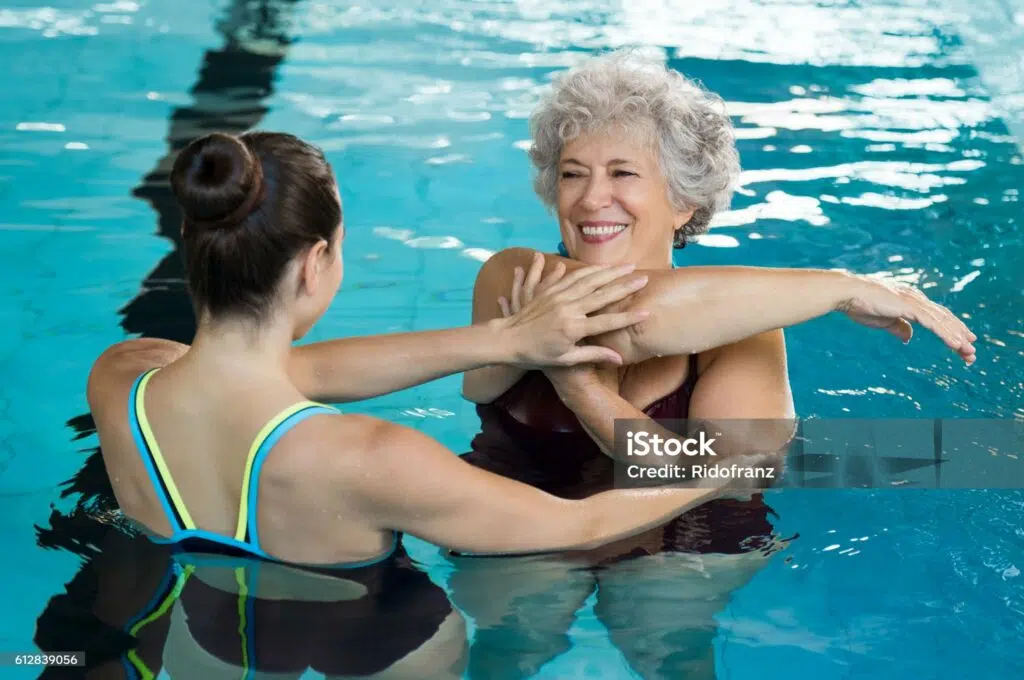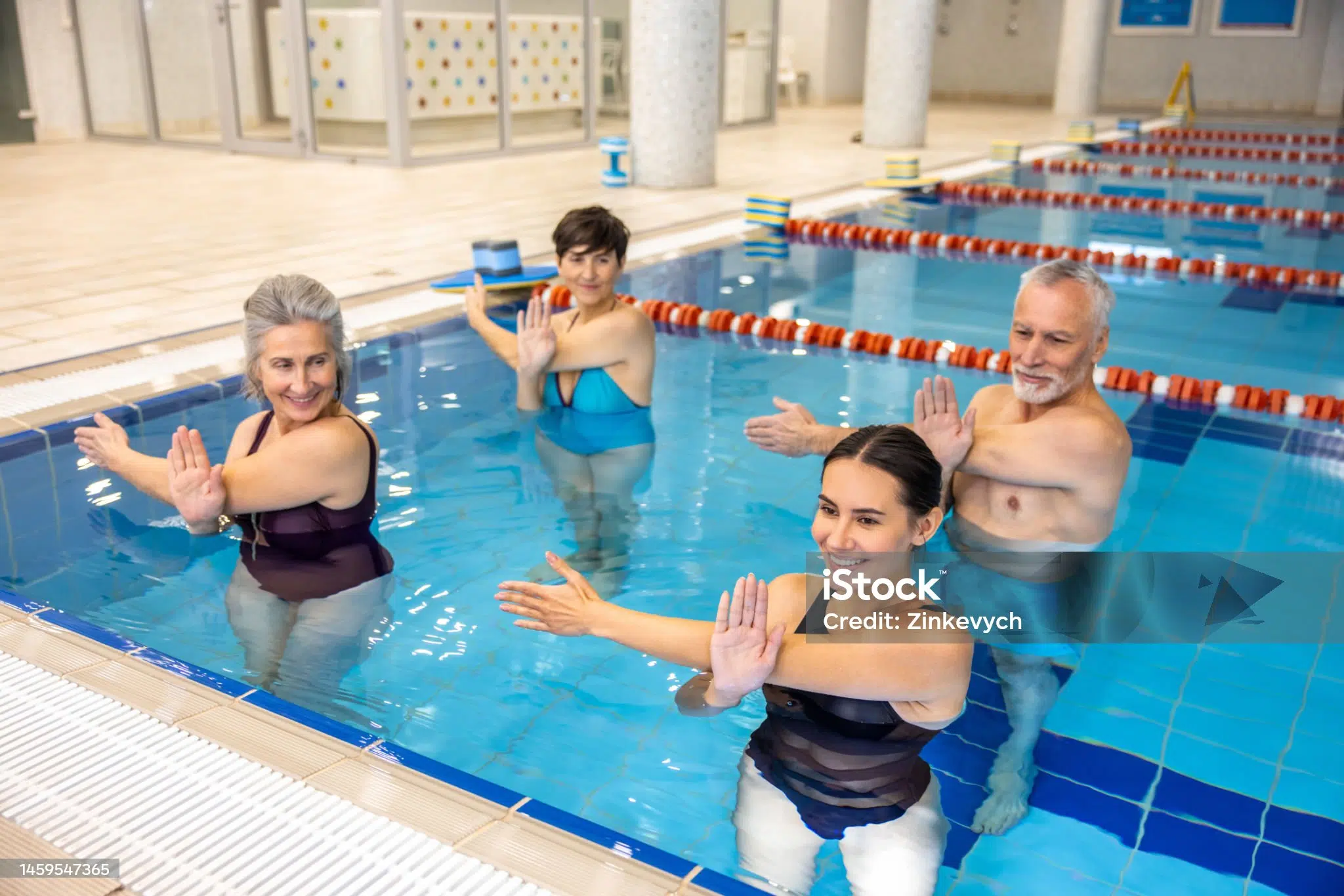Are you getting ready for an aquagym session? Warming up is crucial to avoid injury and optimize your performance. This article explains why and how to warm up properly before diving into the water.
The ideal warm-up combines dry and water exercises. It gently prepares your body and improves your flexibility and responsiveness. Specific routines are detailed to maximize your profits.
Ready to discover the best warm-up exercises for aquagym? Read on for practical tips and real-world examples tailored to your level.
Why is it important to warm up before an aquagym session?
Warming up before an aquagym session is crucial for several reasons. You will discover why this step should never be neglected.
Prevent Injuries
Warming up helps prepare your body for exercise, thereby reducing the risk of injury. By gradually increasing your body temperature, you prepare your muscles and joints for physical activity. This reduces the risk of muscle tears, sprains or tendinitis, common injuries in aqua aerobics. Additionally, a good warm-up improves your coordination, thereby reducing the risk of accidents.
Improve performances
A warm body functions optimally. You will find that your agility and endurance are improved. Warming up increases blood circulation, which delivers more oxygen and nutrients to your muscles. Result ? You are faster, stronger and more endurance. Additionally, good mental preparation helps you focus and maximize your performance throughout the session.
A warmed body is more flexible and responsive
When you take the time to warm up properly, your muscles become more flexible and your joints more mobile. This facilitates range of motion and improves your responsiveness. You'll also notice that you're less likely to feel stiff or sore after training. In short, a warmed body is a body ready to perform without constraints.
How to properly warm up for aquagym?
The warm-up for aquagym is divided into two phases: dry exercises and water exercises. Each of these phases is essential to prepare your body for a effective aquasculpt session or secure aquagym.
Dry exercises before entering the water
Before you even hit the water, it is crucial to prepare your body for the effort. Here's how to do it:
Rotational movements of the joints
Start with gentle rotations of the joints. Make circles with your ankles, knees, hips, wrists and shoulders. These simple movements activate your joints and prevent injuries.
Gentle stretches of major muscle groups
Then move on to gentle stretching. Focus on major muscle groups like the quads, hamstrings, arms and back. For example, gently stretch your legs by touching your toes without straining. This makes your muscles more flexible and ready for exercise.
Example dry warm-up routine
Here is a simple routine to follow:
- Ankle and wrist rotations : 10 repetitions per side.
- Hip and shoulder rotations : 10 repetitions per side.
- Quadriceps and Hamstring Stretches : Hold each stretch for 20 seconds.
Water exercises at the start of the session
Once in the water, continue the warm-up to adapt your body to the aquatic environment.
Water walk to gradually warm up
Start by walking in the water. This water walk allows you to gradually warm up your muscles and activate your blood circulation. Walk for 5 minutes, gradually increasing the pace.
Arm and leg movements to mobilize the joints
Then perform arm and leg movements. Do arm circles, leg kicks, and knee raises. These exercises mobilize your joints gently and effectively.
Light muscle strengthening exercises
Include light muscle-strengthening exercises. For example, do forward lunges or knee raises. Use the water dumbbells to add light resistance.
Example Aquatic Warm-Up Routine
Here is an aquatic warm-up routine:
- Water walk : 5 minutes.
- Arm circle : 10 repetitions.
- Knee raises : 10 repetitions per leg.
- Front lunges : 10 repetitions per leg.
By following these steps, you will be perfectly warmed up for an optimal aquagym session without risk of injury.
What are the best warm-up exercises for water aerobics?
To maximize the benefits of your aquagym session, it is crucial to warm up properly. Here are the best warm-up exercises, divided into three categories: joint mobility, light muscle strengthening and cardiovascular.
Joint mobility exercises
Joint mobility is essential to prepare your joints for exercise.
Rotations of ankles, knees, hips
The rotations are simple but effective. Make circles with your ankles, knees and hips. These movements stimulate blood circulation and improve the flexibility of your joints. Repeat each rotation 10 times in each direction.
Arm movements (rotations, side raises)
For the arms, perform rotations and side raises. Raise your arms to shoulder height and make circles. Then lift them sideways and hold for a few seconds. Repeat these movements to prepare your shoulders and arms.
Gentle stretches for the back, hamstrings, quadriceps
Gentle stretching is essential. Lean forward to touch your toes, stretching your hamstrings. For quads, hold your ankle behind you and hold the position. For your back, lean sideways. Hold each stretch for 20 seconds.
Light muscle strengthening exercises
These exercises gently prepare your muscles.
Knee raises, forward lunges, shallow squats
Knee raises are ideal for warming up your legs. Alternate bringing each knee toward your chest. Forward lunges strengthen your thighs and glutes. Shallow squats prepare your thighs and knees. Repeat each exercise 10 times.
Pull-ups in water with elastics or aquatic dumbbells
Use resistance bands or aquatic dumbbells for light pull-ups. This strengthens your arms and back without overloading your muscles. Do 10 pull-ups for each exercise.
Tips for performing movements correctly and avoiding injuries
To avoid injury, maintain good posture. Keep your back straight and engage your core. Breathe deeply and never force a movement. Listen to your body and adjust the intensity according to your comfort.
Cardiovascular warm-up exercises
These exercises gradually increase your heart rate.
Brisk water walk or run in water
Start with a brisk walk in the water, then progress to a light run. These exercises increase your heart rate and activate your muscles. Walk or run for 5 minutes.
Water stirring movements with the arms
Swirl the water with your arms to warm up your upper body. Use pushing and pulling movements. Repeat these movements for 2 minutes.
High knee raises to get your heart rate up
High knee raises are great for cardio. Raise your knees to your chest dynamically. Do this exercise for 2 minutes to raise your heart rate.
By integrating these exercises into your warm-up routine, you are optimally preparing your body for an effective and enjoyable aquagym session.
Recommended duration for warming up before aqua aerobics
To get the most out of your water aerobics session, a proper warm-up is essential. Here are the duration recommendations for each phase of the warm-up.
10 to 15 minutes of complete warm-up
A complete warm-up should last between 10 and 15 minutes. This helps gradually prepare your body for exercise, thus reducing the risk of injury and improving your performance.
5 minutes of dry exercises
Before entering the water, start with 5 minutes of dry exercises. These exercises include joint rotations, gentle stretches, and light muscle-strengthening movements. Here is an example routine:
- Joint rotations : 1 minute (ankles, knees, hips, wrists, shoulders).
- Gentle stretches : 2 minutes (quadriceps, hamstrings, back).
- Light muscle strengthening : 2 minutes (knee raises, forward lunges).
5 to 10 minutes of water exercises
Once in the water, continue with 5 to 10 minutes of aquatic exercises. These exercises should gradually increase in intensity to prepare your body for the main session. Here is an example of an aquatic routine:
- Water walk : 3 minutes to warm up the muscles.
- Arm and leg movements : 3 minutes to mobilize the joints.
- Light muscle strengthening exercises : 2 to 4 minutes (lunges, knee raises).
Importance of listening to your body and adjusting if necessary
It's crucial to listen to your body's signals. If you experience pain or excessive fatigue, adjust the intensity or duration of the warm-up. Do not hesitate to extend the warm-up if you feel the need. Every body is unique, and it's important to adapt your routine to how you feel.
Adapt according to the level and planned intensity
The duration of the warm-up should also be adapted according to your fitness level and the intensity of the planned session.
Longer warm-up for intense session or beginner
For an intense session or if you are a beginner, a longer warm-up is recommended. Spend 15 minutes warming up, gradually increasing the intensity of the exercises. This helps prepare your muscles and joints for more sustained effort and minimizes the risk of injury.
Shorter warm-up possible for light session and trained person
For a lighter session or if you are already well trained, a 10-minute warm-up may be enough. You can slightly reduce the duration of dry and water exercises, ensuring that your body is still well prepared for the effort.
A good warm-up is the key to a successful aquagym session. By respecting these duration recommendations, you ensure that you start your training in the best possible conditions.
Additional tips for a good aqua aerobics warm-up
To maximize the benefits of your warm-up and ensure an effective and safe aquagym session, here are some additional tips to follow.
Hydrate well before the session
Hydration is essential, even for aquatic activity. Drink water before, during and after your aquagym session. Proper hydration helps maintain your energy levels and prevent muscle cramps. Consider drinking at least a large glass of water 30 minutes before starting your warm-up.
Wear suitable clothing and shoes
The choice of clothing and shoes is crucial for a good warm-up. Opt for a comfortable swimsuit that does not restrict your movements. If you use water shoes, make sure they fit properly and provide good support to prevent slipping. Appropriate clothing allows you to move freely and safely.
Respect your limits and listen to your body’s signals
It is important to respect your physical limits. Never force a movement that causes pain. Listen to your body and stop if you feel any pain or discomfort. The goal of warming up is to prepare your body, not to tire or damage it. Pay attention to your feelings and adjust the intensity of the exercises accordingly.
Seek advice from a professional if in doubt
If you have any doubts about the exercises to perform or how to perform them, do not hesitate to seek advice from a professional. A personal trainer or aqua gym instructor can provide you with personalized advice and ensure that you are performing the movements correctly. This can prevent injuries and improve the effectiveness of your warm-up.
By following these additional tips, you will optimize your preparation and ensure a pleasant and risk-free aquagym session. Warming up is a key step to fully benefit from the benefits of aquagym.
Conclusion
Warming up before water aerobics is essential to prevent injuries and improve performance. Following a dry and wet routine ensures optimal preparation. Always adapt the warm-up to your level and the intensity of the session.
Mobility, strengthening and cardio exercises are essential. Hydrate well, wear appropriate clothing and respect your limits. Do not hesitate to consult a professional for personalized advice.
Check out our other articles to learn more about aqua aerobics and other water sports. Improve your well-being and performance with our expert advice.
An aquagym session at Aqua by
If you like swimming or aquatic activities, discover aquabike at Aqua by. Enjoy dynamic group classes in an immersive atmosphere, ideal for challenging yourself and escaping.
Each 45-minute session is supervised by motivating coaches, suitable for all fitness levels. After exercise, relax in our sauna or hammam for some well-deserved relaxation.
Want to try aquabike? Join us in Paris (Bastille, Charonne, Réaumur) or Boulogne! Reserve your place now and dive into the aquatic adventure! 💦







